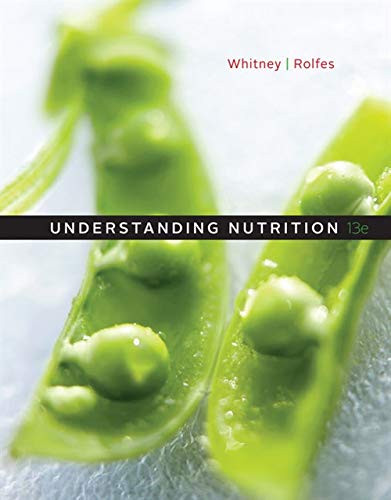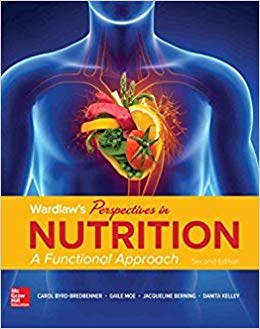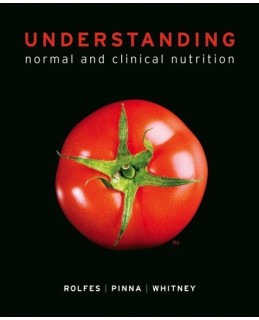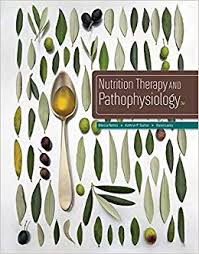Understanding Nutrition 13th Edition by Eleanor Noss Whitney – Test Bank
Original price was: $55.00.$20.00Current price is: $20.00.
Digital item No Waiting Time Instant Download
ISBN-13: 978-1133606789
ISBN-10: 1133606784
Publisher : Cengage Learning
Author: by Eleanor Noss Whitney,
Sharon Rady Rolfes
Description
Understanding Nutrition 13th Edition by Eleanor Noss Whitney – Test Bank
Table of Contents
A Note on Test Bank Style and Use iv
Part 1 – Test Bank for Understanding Nutrition 1
Chapter 1 – An Overview of Nutrition 1
Chapter 2 – Planning a Healthy Diet 15
Chapter 3 – Digestion, Absorption, and Transport 29
Chapter 4 – The Carbohydrates: Sugars, Starches, and Fibers 46
Chapter 5 – The Lipids: Triglycerides, Phospholipids, and Sterols 64
Chapter 6 – Protein: Amino Acids 85
Chapter 7 – Energy Metabolism 103
Chapter 8 – Energy Balance and Body Composition 118
Chapter 9 – Weight Management: Overweight, Obesity, and Underweight 132
Chapter 10 – The Water-Soluble Vitamins: B Vitamins and Vitamin C 148
Chapter 11 – The Fat-Soluble Vitamins: A, D, E, and K 171
Chapter 12 – Water and the Major Minerals 188
Chapter 13 – The Trace Minerals 207
Chapter 14 – Fitness: Physical Activity, Nutrients, and Body Adaptations 228
Chapter 15 – Life Cycle Nutrition: Pregnancy and Lactation 245
Chapter 16 – Life Cycle Nutrition: Infancy, Childhood, and Adolescence 264
Chapter 17 – Life Cycle Nutrition: Adulthood and the Later Years 285
Chapter 18 – Diet and Health 299
Chapter 19 – Consumer Concerns about Foods and Water 317
Chapter 20 – Hunger and the Global Environment 338
Part 2 – Test Bank for Nutrition Pathways Telecourse Videos 349
(Provided by Marie Yost Maness of Dallas County Community College District)
Lesson 1: Nutrition Basics 349
Lesson 2: The Digestive System 351
Lesson 3: Carbohydrates: Simple and Complex 353
Lesson 4: Carbohydrates: Fiber 354
Lesson 5: Fats: The Lipid Family 357
Lesson 6: Fats: Health Effects 359
Lesson 7: Protein: Form and Function 361
Lesson 8: The Protein Continuum 363
Lesson 9: Metabolism 364
Lesson 10: Weight Control: Energy Regulation 365
Lesson 11: Weight Control: Health Effects 367
Lesson 12: Vitamins: Water-Soluble 370
Lesson 13: Vitamins: Fat-Soluble 371
Lesson 14: Major Minerals and Water 373
Lesson 15: Trace Minerals 376
Lesson 16: Physical Activity: Fitness Basics 379
Lesson 17: Physical Activity: Beyond Fitness 382
Lesson 18: Life Cycle: Pregnancy 384
Lesson 19: Life Cycle: Lactation and Infancy 386
Lesson 20: Life Cycle: Childhood and Adolescence 388
Lesson 21: Life Cycle: Adulthood and Aging 390
Lesson 22: Diet and Health: Cardiovascular Disease 392
Lesson 23: Diet and Health: Cancer, Immunology, and AIDS 395
Lesson 24: Diet and Health: Diabetes 399
Lesson 25: Consumer Concerns and Food Safety 402
Lesson 26: Applied Nutrition 405
Chapter 1 – An Overview of Nutrition
Multiple Choice
1. Which of the following is NOT among the features of a chronic disease?
a. It develops slowly
b. It lasts a long time
c. It produces sharp pains
d. It progresses gradually
2. What is the chief reason people choose the foods they eat?
a. Cost
b. Taste
c. Convenience
d. Nutritional value
3. Which of the following is NOT among the consequences of making poor food choices?
a. Over the long term, they will reduce lifespan in some people
b. They can promote heart disease and cancer over the long term
c. Over the long term, they will not affect lifespan in some people
d. When made over just a single day, they exert great harm to your health
4. A child’s strong dislike of noodle soup that developed after she consumed some when she was sick with flu is an example of a food-related
a. habit.
b. social interaction.
c. emotional turmoil.
d. negative association.
5. A parent who offers a child a favorite snack as a reward for good behavior is encouraging a food behavior known as
a. social interaction.
b. reverse psychology.
c. positive association.
d. habitual reinforcement.
6. A person who eats a bowl of oatmeal for breakfast every day is most likely making a food choice based on
a. habit.
b. availability.
c. body image.
d. environmental concerns.
7. Which of the following represents a food choice based on negative association?
a. A tourist from China who rejects a hamburger due to unfamiliarity
b. A child who spits out his mashed potatoes because they taste too salty
c. A teenager who grudgingly accepts an offer for an ice cream cone to avoid offending a close friend
d. An elderly gentleman who refuses a peanut butter and jelly sandwich because he deems it a child’s food
8. The motive for a person who alters his diet due to religious convictions is most likely his
a. values.
b. body image.
c. ethnic heritage.
d. functional association.
9. A person viewing an exciting sports match of her favorite team and eating because of nervousness would be displaying a food choice behavior most likely based on
a. habit.
b. availability.
c. emotional comfort.
d. positive association.
10. Approximately what percentage of US consumers eat home-cooked meals at least 3 times per week?
a. 20
b. 40
c. 60
d. 80
11. All of the following are examples of functional foods EXCEPT
a. tomatoes.
b. regular oatmeal.
c. regular white bread.
d. calcium-fortified juice.
12. What is the term that defines foods that contain nonnutrient substances whose known action in the body is to promote well-being to a greater extent than that contributed by the food’s nutrients?
a. Fortified foods
b. Enriched foods
c. Functional foods
d. Health-enhancing foods
13. Nonnutrient substances found in plant foods that show biological activity in the body are commonly known as
a. folionutrients.
b. inorganic fibers.
c. phytochemicals.
d. phyllochemicals.
14. By chemical analysis, what nutrient is present in the highest amounts in most foods?
a. Fats
b. Water
c. Proteins
d. Carbohydrates
15. Approximately how much water (lbs) would be found in a 120-lb person?
a. 12
b. 24
c. 36
d. 72
16. Which of the following is NOT one of the six classes of nutrients?
a. Fiber
b. Protein
c. Minerals
d. Vitamins
17. A nutrient needed by the body and that must be supplied by foods is termed a(n)
a. neutraceutical.
b. metabolic unit.
c. organic nutrient.
d. essential nutrient.
18. Which of the following is NOT classified as a macronutrient?
a. Fat
b. Protein
c. Calcium
d. Carbohydrate
19. Which of the following is an example of a macronutrient?
a. Protein
b. Calcium
c. Vitamin C
d. Vitamin D
20. Which of the following is classified as a micronutrient?
a. Iron
b. Protein
c. Alcohol
d. Carbohydrate
21. Which of the following is an organic compound?
a. Salt
b. Water
c. Calcium
d. Vitamin C
22. An essential nutrient is one that cannot be
a. found in food.
b. degraded by the body.
c. made in sufficient quantities by the body.
d. used to synthesize other compounds in the body.
23. Which of the following most accurately defines the term organic?
a. Products sold at health food stores
b. Products grown without use of pesticides
c. Foods having superior nutrient qualities
d. Substances with carbon-carbon or carbon-hydrogen bonds
24. Which of the following is an organic nutrient?
a. Fat
b. Water
c. Oxygen
d. Calcium
25. Approximately how many nutrients are considered indispensable in the diet?
a. 15
b. 25
c. 40
d. 55
26. Which of the following cannot add fat to the body?
a. Alcohol
b. Proteins
c. Carbohydrates
d. Inorganic nutrients
27. Which of the following is an example of a micronutrient?
a. Fat
b. Protein
c. Vitamin C
d. Carbohydrate
28. Which of the following nutrients does not yield energy during its metabolism?
a. Fat
b. Proteins
c. Vitamins
d. Carbohydrates
29. How much energy is required to raise the temperature of one kilogram (liter) of water 1° C?
a. 10 calories
b. 1 kilocalorie
c. 10,000 calories
d. 1000 kilocalories
30. Gram for gram, which of the following provides the most energy?
a. Fats
b. Alcohol
c. Proteins
d. Carbohydrates
31. Food energy is commonly expressed in kcalories and in
a. kilojoules.
b. kilograms.
c. kilometers.
d. kilonewtons.
32. International units of energy are expressed in
a. newtons.
b. calories.
c. kilojoules.
d. kilocalories.
33. Approximately how many milliliters are contained in a half-cup of milk?
a. 50
b. 85
c. 120
d. 200
34. A normal half-cup vegetable portion weighs approximately how many grams?
a. 5
b. 50
c. 100
d. 200
35. A weight reduction regimen calls for a daily intake of 1400 kcalories, which includes 30 g of fat. Approximately what percentage of the total energy is contributed by fat?
a. 8.5
b. 15
c. 19
d. 25.5
36. A diet provides a total of 2200 kcalories, of which 40% of the energy is from fat and 20% from protein. How many grams of carbohydrate are contained in the diet?
a. 220
b. 285
c. 440
d. 880
37. What is the kcalorie value of a meal supplying 110 g of carbohydrates, 25 g of protein, 20 g of fat, and 5 g of alcohol?
a. 160
b. 345
c. 560
d. 755
38. Which of the following nutrient sources yields more than 4 kcalories per gram?
a. Plant fats
b. Plant proteins
c. Animal proteins
d. Plant carbohydrates
39. Which of the following is a result of the metabolism of energy nutrients?
a. Energy is released
b. Body fat increases
c. Energy is destroyed
d. Body water decreases
40. Which of the following statements most accurately describes the composition of most foods?
a. They contain only one of the three energy nutrients, although a few contain all of them
b. They contain equal amounts of the three energy nutrients, except for high-fat foods
c. They contain mixtures of the three energy nutrients, although only one or two may predominate
d. They contain only two of the three energy nutrients, although there are numerous other foods that contain only one
41. In the body, the chemical energy in food can be converted to any of the following EXCEPT
a. heat energy.
b. light energy.
c. electrical energy.
d. mechanical energy.
42. When consumed in excess, all of the following can be converted to body fat and stored EXCEPT
a. sugar.
b. corn oil.
c. alcohol.
d. vitamin C.
43. How many vitamins are known to be required in the diet of human beings?
a. 5
b. 8
c. 10
d. 13





Be the first to review “Understanding Nutrition 13th Edition by Eleanor Noss Whitney – Test Bank”